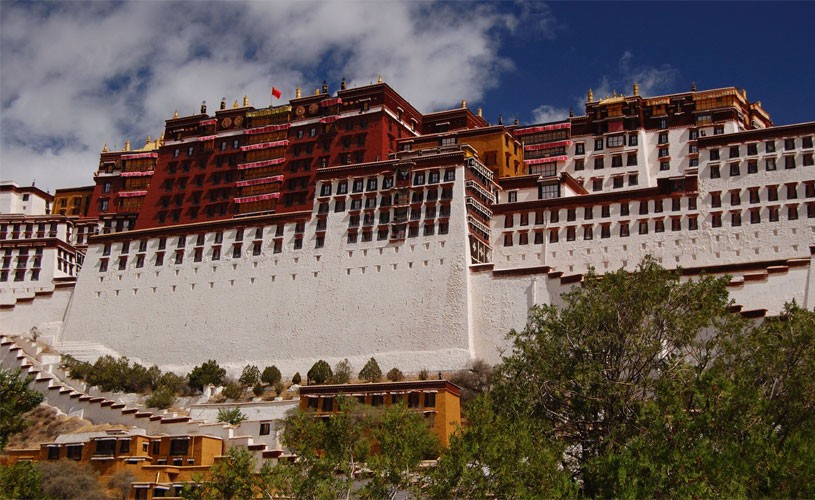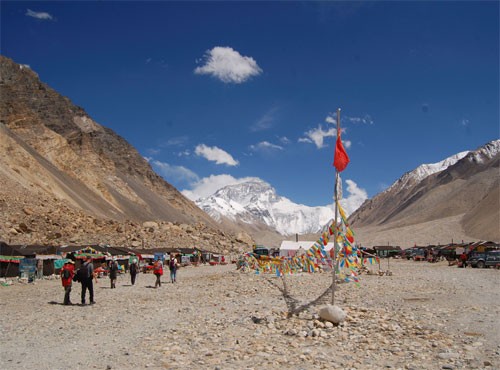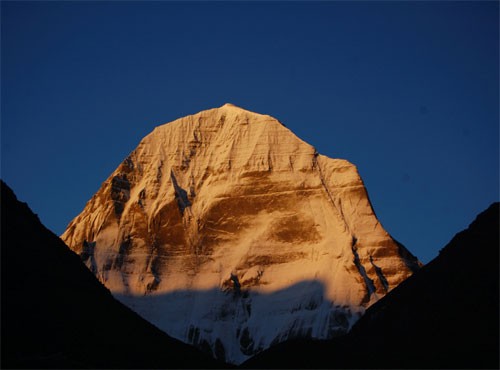Lhasa to Everest Base Camp Tour Highlights:
- World Heritage Sites, Potala Palace, and Norbulingka Palace
- Sera Monetary and Drepung Monastery, are two great Gelug University of Tibet
- Jokhang Temple, a sacred temple of Tibet
- TashiLhunpo Monastery houses successive Panchen Lamas
- Rongbuk Monastery, the highest monastery in Tibet
- View of the north face of Everest from the Everest Base Camp
- YamdrokTso Lake, one of three holy lakes in Tibet
- Visit popular Tibetan landmarks such as Potala Palace and Rongbuk monastery
- Cross high passes like Karo La and Khamba La
Lhasa to Everest Base Camp Tour: An Unforgettable 8-Day Adventure
The Lhasa To Everest Base Camp Tour captures Tibet's spiritual, historical, and natural essence. It leaves us with an unforgettable feeling of fulfillment and a treasure chest of memories.
The Lhasa to Everest Base Camp (EBC) Tour is an 8-day journey starting and ending in Lhasa, Tibet’s vibrant capital. This adventure takes you through stunning landscapes, including pristine lakes, glaciers, rivers, and farming valleys, all framed by breathtaking Himalayan views. The highlight of the trip is reaching Everest Base Camp, the base of the world’s highest mountain, where the majestic sight of Mt. Everest feels like a life-changing achievement.
This tour covers the historical Tibetan cities and towns of Lhasa, Gyantse, Shigatse, and Rongbuk, offering a rich cultural experience. You’ll explore iconic landmarks like the Potala Palace, Norbulingka Palace, the Tibet Traditional Hospital, Barkhor Bazaar, and Gyantse Dzong. Along the way, you’ll cross high mountain passes and visit the stunning turquoise waters of Yamdrok Tso Lake.
The journey also includes stops at Tibet’s most impressive monasteries, such as Sera, Drepung, Jokhang Temple, Khumbum Stupa, Tashi Lhumpo, Sakya, and Rongbuk Monastery. Spanning a distance of approximately 800 kilometers, the Lhasa to EBC tour combines Tibet’s most famous and sacred sites into the ultimate travel package, creating memories that will last a lifetime.
Rongbuk Monastery lies at a height of 5,000m/16,4000ft. You will pass through several high passes on your way to Mt. You'll have to pass several high passes on your way up Mt. Enjoy the breathtaking scenery on Mt. You'll also enjoy the stunning scenery of Mt. Cho Oyu (8.188m/26.906ft) and Mt. Shishapangma (8.27m/26.289ft) from Geu La Pass.
Rongbuk, the world's highest Tibetan Buddhist monastic monastery, is located near Everest's base camp. In Tibet, the gateway to Mt. Everest is called Chomolungma, Chomolungma, and Chomolungma. The perfect spot to watch the sunrise or sunset over Mt. There is also a beautiful round chorten in the monastery and statues of Shakyamuni. Also, there are beautiful round chortens with statues of Shakyamuni. Old mural paintings depict Tibetan cultures and religions.
After a lovely time at Rongbuk Monastery, you will travel early the next day to Everest Base Camp. Another highlight of the trip is this stop. This North Everest Base Camp is known for its beauty and mountains. After exploring the base camp, you will drive back to Shigatse via the Friendship Highway. Then, you'll return to Lhasa by way of Yalong Valley. Enjoy the Tibetan plateau scenery. Then, you will continue to your next destination. The eight-day Lhasa Base Camp Tour will end when you reach your final destination.
Food During Lhasa to EBC Tour
On this trip, only breakfasts are provided. You'll need to pay for your lunches and dinners. Breakfast will be served where we stay overnight, and dinner arrangements can be similar. Lunch will be eaten while we're traveling to the next place. We suggest budgeting around Yuan 60 to Yuan 100 (US$10 to US$16) per day for lunch and dinner. Our meals will include Tibetan bread, dal (lentil soup), bhat (rice), tsampa porridge, and other basic local dishes.
Accommodation During The Tour
We will stay at the Kyichu Hotel in Lhasa, the Yeti Hotel in Gyantse, the Gesar Hotel in Shigatse, and the Rongbuk Monastery Guest House in Rongbuk. While accommodations in Lhasa can be upgraded upon request, those in other cities and towns represent the best available options. Rooms are provided on a twin-sharing basis, but a single supplement can be arranged for an additional cost.
Travel Documents Required for Entry to Tibet
Passport: All travelers must have a passport valid for at least 6 months.
Chinese Visa: This can be obtained from a Chinese Embassy or through China Highlights if entering Tibet from China.
Group Visa: Required for travelers entering Tibet from Nepal. After the Tibet tour, travelers can continue to mainland China with a valid group visa.
Note: An individual Chinese visa in your passport will be canceled if a group visa is issued.
Tibet Entry Permit
Issued by the Tibet Tourism Bureau, this is a mandatory document for all foreigners entering Tibet.
Additional Permits for Specific Areas
Travel Permit: Required for access to restricted areas within Tibet. This permit is issued after your arrival in Tibet.
Military Permit: Necessary for visiting certain militarily sensitive regions in Tibet. Ensure all required documents are in order before your trip to enjoy a smooth and hassle-free journey to Tibet.
Visa Process for Tibet Overland Tour from Nepal
According to the latest regulations from the Chinese Embassy in Nepal, a minimum of four people is required to apply for a Tibet group visa. The application process in Kathmandu involves submitting the original passport and typically takes 3–4 official working days to complete.
Please note that visa requirements and regulations are subject to frequent changes. We recommend confirming the latest requirements with Adventure Club Trek before booking your Tibet tour to ensure a smooth process.
The Chinese government frequently updates its visa regulations. If any new rules are introduced in the future, we will promptly provide updated information.
Safety Guidelines
We recommend you go through our safety guidelines and stay tuned with the latest happenings.
- Have at least two copies of the Tibet Permit.
- Keep your belongings properly.
- When you feel uncomfortable due to altitude change or troubles, report to train staff promptly.
- Take your time visiting attractions shortly after you arrive in Lhasa.
- Shop around but avoid undue bargaining with street vendors and never buy wildlife and unknown Tibetan herbal medicine and fake products.
- Take your money and essential belongings with you all the time.
- Spend a few days in Lhasa for acclimation and consistently follow a gradual ascent when traveling to higher places to avoid altitude sickness.
- Refrain from heavy drinking and smoking.
- Respect the religion and customs and avoid taboos in Tibet.
- Pay special attention to the unique alpine climates (such as sunburn, dramatic temperature change, etc.)
- Keep the necessary medicines at your doctor's consultation.
- Travel alone at night or venture into unknown places without informing your guide.
- In most places, cash is only accepted. Do prepare enough and minor changes.
- If an emergency arises, report it to your guide promptly.
- Don't carry any documents or papers related to the Dalai Lama or feel Tibet.
- We also recommend not carrying any guidebook to Tibet.
Packing list for Everest Base Camp Tour
- Down jacket
- Thermal underwear,
- Warm headwear
- Sunscreen
- Sun hats
- Toiletries,
- Personal medicines
- Mountain sickness,
- Cold relief, or diarrhea






